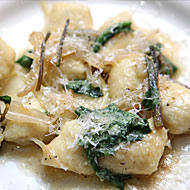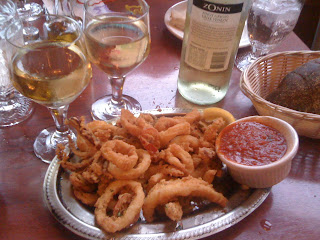Since were were talking about recipe testing, I thought you all might be interested in this piece written by my colleague Irene Chalmers. Her site is
FoodJobsBook.com

June 9, 2010

Karen Berner, Food Editor, photo courtesy of Gloria Dawson
There are very few people I know whose career paths have moved in a straight line. The real constant is how they have matched and used their innate skills with their passion and possibility. I find these people the most interesting, don’t you? Take Karen Berner, for instance.
Karen is a successful food editor of websites and print, who combined a Fine Arts degree, an editor’s eye for accuracy, and a former IBM technical writer’s ability to communicate clearly and concisely. And, she changed careers to pursue her passion for food. Here, below, in her own words, is Karen’s recipe for success:
My path to the food-editorial world was somewhat unconventional. A
career-changer at 37, I decided to pursue my secret dream of becoming a professional chef by enrolling at the
Culinary Institute of America (CIA). But once there, I quickly realized there were many other interesting careers related to food outside of a restaurant kitchen.
My initial thoughts of happily toiling away behind the line changed when I was given the opportunity to do studio and test kitchen work for a food website geared to both professional chefs and cooking enthusiasts. It was the perfect fit; I’d be intimately involved with food, but this type of work would also tap into my creative side, one I still like to nurture every day.

Culinary Institute of America
My beginnings in the food world were humble. I started out working part-time in the CIA cookbook department, dealing with recipes for every cuisine under the sun. This job quickly led to producing food content and recipes in a test kitchen for a website. Here, I further honed my recipe development and editing skills as well as food-styling and photography abilities.
Working at a website, you’re often called on to wear many hats. So, I soon took on the responsibility of interviewing celebrity chefs. I’m sure their insights and contributions inspire many a student and food lover to follow their culinary path, myself included.
I later was able to transfer my skills to print media, working on the well-regarded
Art Culinaire magazine for professional chefs. I essentially was doing the same work I handled for the website but took on more writing assignments. I also learned the tools necessary for putting a magazine together, including dealing with the pressures of deadlines and scheduling. My experience interviewing chefs came in handy; I was able to contribute to the popularity of the magazine while feeding the growing appetite for the inside scoop on celebrity and up-and-coming chefs.
I’d like to think that everything I’ve done up to now – writing, website work, technology knowledge, line cooking, recipe testing, teaching, and even experience as a private chef – has ultimately contributed to what I do today and aspire to do tomorrow.
Many have asked me what skills have made me a successful food editor. I think this can be boiled down to seven:
- Keeping on top of food trends that you know will interest your readers.
- Being able to purpose recipe and content that’s useful, approachable, friendly, and will appeal to a mass audience.
- Strong writing and editing skills, and the ability to adapt to a magazine, cookbook, or a website’s established voice, tone, and style. (Think Martha Stewart vs. Rachael Ray.)
- Strong management and organizational skills.
- Great contacts in the food industry.
- Solid recipe writing skills and the ability to edit ornery recipes when they’re problematic.
- Being able to look at a recipe and troubleshoot what might be wrong with it before you’ve had the chance to test it.
Experience is key and critical to success, but it’s not always enough to land your dream job. Networking (whether via the latest social media venues or simply by getting out there and shaking a few hands) and perseverance are just as important.
Although I’ve worked in many parts of the food industry, I’m most comfortable in a kitchen, where I’m developing and testing recipes, whether for magazines, websites, or cookbooks. Having a solid recipe and ingredient base knowledge opens many a door. Why, I’ve even judged the famous
Pillsbury Bake-Off baking contest. What a hoot!
I’ve also had the opportunity to teach the fundamentals of cooking to food enthusiasts and found this to be extremely rewarding.
I’m happy to share that after many years in the industry I still enjoy what I do — it’s challenging. It’s never the same from day to day, and I get paid to eat. Not too shabby.
But it is important to keep growing, to keep dreaming up the next adventure. If I have my way, my next food adventure will be working on a TV show as part of a culinary production team. I think my test kitchen, food-styling, food photography, management, directing and editing skills will be a value add to the production.

















